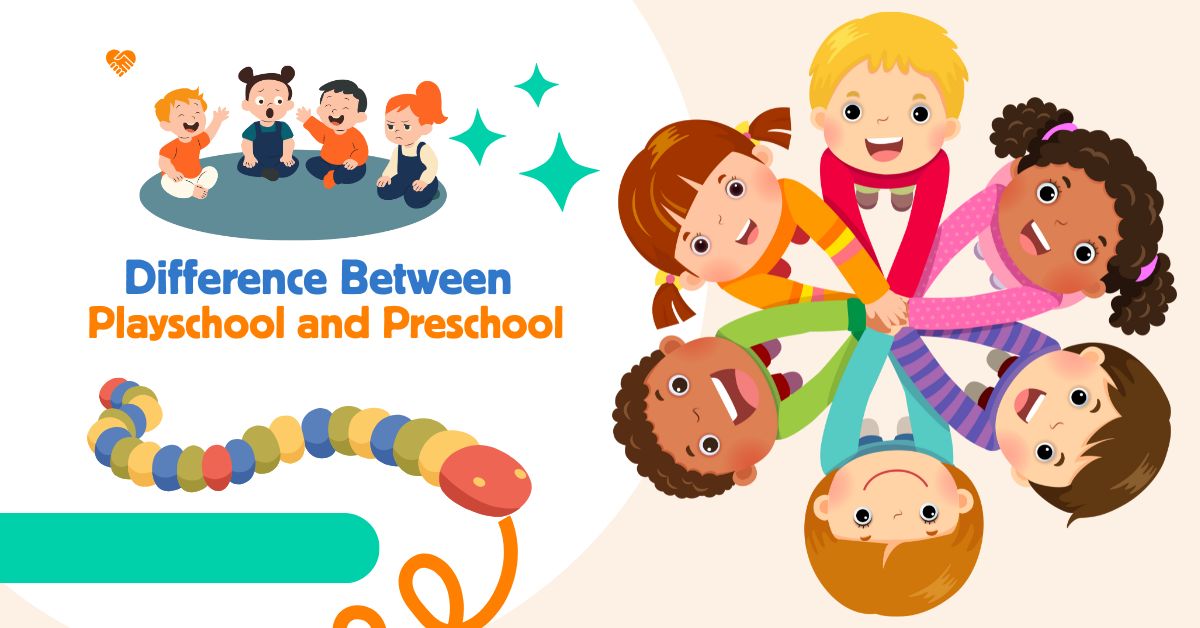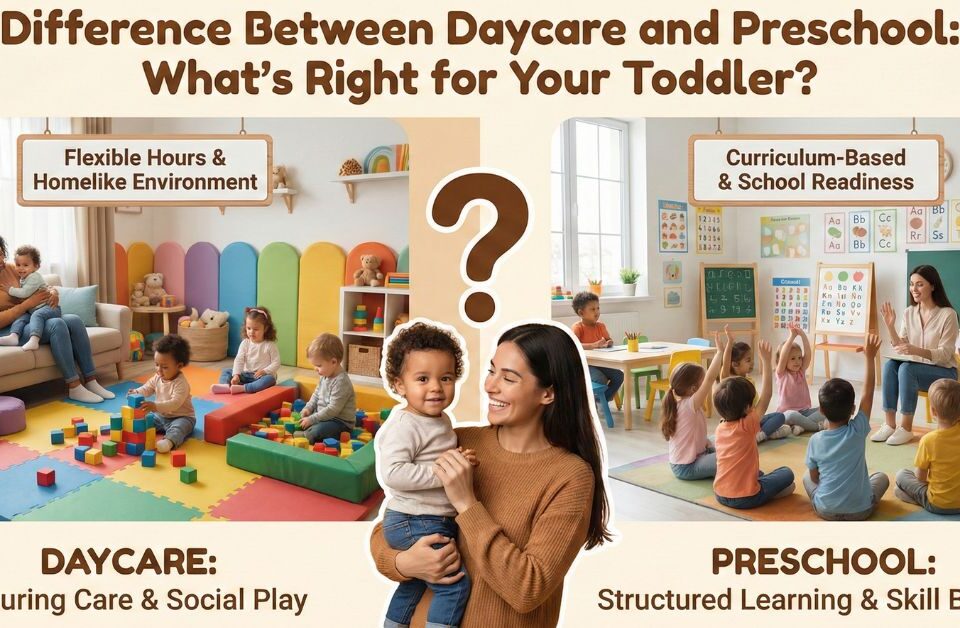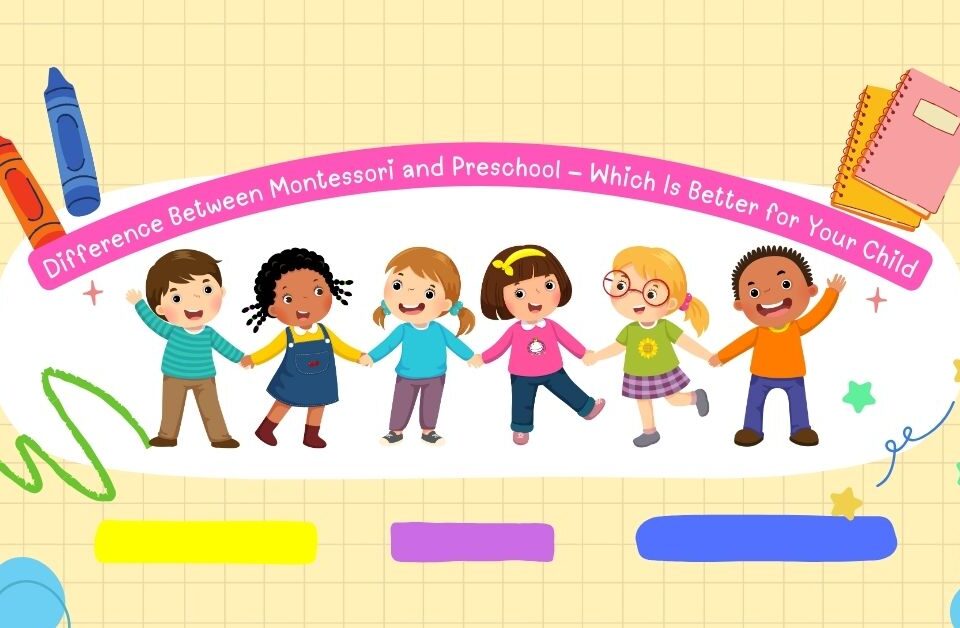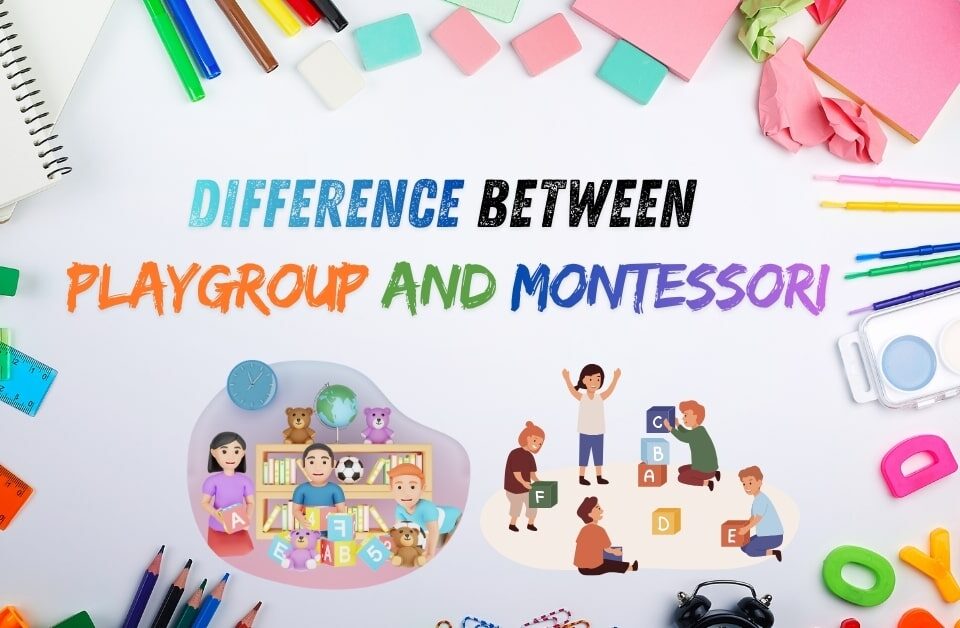
Playgroup vs Montessori: Key Differences & Which Is Better for Your Child
October 28, 2025
Difference Between Montessori and Preschool Explained
November 26, 2025Difference Between Playschool and Preschool: A Complete Guide for Parents
Understanding the Difference Between Playschool and Preschool
The early years of childhood are filled with curiosity, wonder, and rapid growth. As a parent, you obviously want to give your little one the best start in life! Hence, one of the first decisions you face on this journey is choosing the right early learning space. Many parents find themselves confused about the difference between playschool and preschool. It’s quite natural to be unsure which one fits their child’s age, personality, and developmental needs.
If you’re facing a dilemma and wondering between playschool vs preschool, this guide will help you understand both in a clear, simple, and parent-friendly way!
The purpose is to support you in making an informed choice that feels right for your child. That’s because the early decisions may end up playing a significant role in shaping their future.
What Is Playschool? Meaning, Benefits, & Ideal Age
The most important question is, “What is a playschool?” It is often a child’s first step outside their home and into a social learning environment.
This space is actually designed for very young children who are just beginning to explore the world beyond familiar faces and spaces.
1: Age Group: Who Is Playschool Meant For?
Playschools usually welcome toddlers between 1.5 to 3 years of age. At this stage, children need more emotional comfort, gentle guidance, and care rather than structured lessons.
Also Read: What Is the Right Age for Play School Admission?
2: Learning Approach: How Play-Based Learning Shapes Toddlers
Hence, playschool meaning in education includes early exposure to social interactions, sensory experiences, and simple play-based learning.
Children are encouraged to listen to music, play freely, tell and listen to stories, imitate, and explore. The environment is quite relaxed, comforting, and flexible. There’s no pressure for learning.
3: Environment & Daily Activities in a Playschool
A playschool prioritises a homely and safe environment for toddlers since it’s their first time being away from home.
Hence, the activities include free play, toy time, rhymes, messy play, and sensory activities. The focus remains on emotional security, early social behaviour, and settling into a group setting.
Also Read: Difference Between Playgroup and Nursery: A Parent’s Guide
What Is a Preschool? Structure, Purpose & Early Education Approach
Next, we must ask, “What is a preschool?” As children grow slightly older, they begin to need more structured learning experiences. This helps them to prepare for formal schooling, and that’s where a preschool steps in!
1: Age Group: The Right Age to Start Preschool
A preschool is usually designed for children who are aged between 3 and 5 years. It’s a phase where little learners are curious, communicative, and ready to grasp early concepts and classroom routines.
2: Curriculum: Early Concepts & Skill-Building for Young Learners
A preschool curriculum introduces early learning for kids. The environment still encourages fun and hands-on learning; however, now there’s a greater sense of purpose and progression.
Children learn with the help of guided activities, play time, storytelling, themed projects, and foundational academic concepts!
3: How Preschool Prepares Children for Formal Schooling
The aim of preschool is to prepare children for kindergarten or formal schooling. The approach includes teaching them independence, problem-solving, expressive skills, social etiquette, and cognitive abilities.
Thus, children develop habits like sitting in class, following routines, sharing, expressing feelings, and participating in group activities.
Playschool vs Preschool: 4 Key Differences Every Parent Should Know
Parents often ask, “Which is better: playschool or preschool?” The truth is, both serve different purposes, and the right decision is actually based on your child’s age and developmental stage.
Hence, understanding the core differences can make the decision significantly easier!
1: Age Criteria & Admission Requirements
The first point of discussion is the age difference between play school and preschool. A playschool is more suitable for toddlers who are just learning how to socialise.
On the other hand, a preschool is for children who are ready to learn foundational concepts and prepare for formal schooling.
2: Curriculum Style: Play-Based vs Structured Learning
In a playschool, the learning is entirely play-based, unstructured, and more focused on familiarity and comfort.
In contrast, a preschool introduces a well-designed curriculum with structured activities. These help to support cognitive, emotional, and social growth. Thus, it bridges the gap between early learning for toddlers and formal school education.
3: Developmental Needs Supported in Each Setting
A playschool supports your child’s early emotional development, eases their separation from their family, and provides social comfort. However, a preschool is one step forward. It helps children build early academic skills, communication abilities, and independence.
4: School Readiness and Long-Term Benefits
Thus, in early childhood education comparison, a playschool gently introduces children to a school-like setting, while preschool builds the mandatory skills required for primary school.
By the end of preschool, children usually start exhibiting confidence, curiosity, independence, and a positive attitude towards learning!
Which Is Better: Playschool or Preschool? How to Choose the Right Option
The decision of playschool vs preschool becomes easier when you observe your child’s behaviour and evaluate their readiness.
If your little one is still adjusting emotionally, needs more comfort, or is too young for structured learning, a playschool setting would be perfect for their development.
On the other hand, if your child is curious, communicative, and ready to follow small routines, a preschool will offer them more meaningful early learning opportunities to explore their capabilities.
Thus, according to the difference between playschool and preschool, your choice should depend on your child’s comfort, maturity, emotional readiness, and daily behaviour.
Some children benefit greatly from the gentle transition of playschool before stepping into preschool, while others may directly begin with preschool, depending on home exposure and social adaptability!
Common Mistakes Parents Make When Choosing Playschool or Preschool
Despite being adequately informed, it’s okay to make mistakes, especially when you feel pressured by competition, comparisons, or social expectations. Hence, here are a few common mistakes that you can avoid:
- Don’t place your child in a preschool too early. A common misconception is believing early academics create an advantage. In reality, pushing children before they are emotionally ready can impact their confidence and enthusiasm for learning.
- Don’t choose a school solely based on its popularity or convenience. Since early learning for toddlers is a sensitive phase, the right environment matters more than trends.
- It’s important to visit the centre, understand the philosophy, meet the teachers, and observe the ambience to see if it feels comforting and suitable for your child.
Also Read: Playgroup vs Montessori: Key Differences & Which Is Better for Your Child
Making the Best Choice: Playschool or Preschool for Your Child’s Bright Future
The difference between playschool and preschool will help all parents choose an environment that supports their child’s comfort, confidence, and individual pace of development.
There is no one “right” choice for every child. Thus, instead of playschool vs playgroup, what matters most is recognising what your little one needs today.
Is it gentle exposure and settling-in, or a step towards structured learning and school readiness? When the decision comes from awareness rather than pressure, your children are bound to flourish with joy, security, and a lifelong love for learning!
Give Your Child the Best Start at JBM Smart Start Preschool
Give your child the gift of a bright future at JBM Smart Start, Greater Noida’s top preschool! Its thriving environment, qualified educators, and a joyful approach to early learning ensure that the little ones grow with confidence, curiosity, and care.
Frequently Asked Questions: Playschool vs Preschool
Q1: What is the main difference between playschool and preschool?
Ans: The primary difference between playschool and preschool lies in age group and structure. A playschool is for younger toddlers that focuses on emotional comfort and socialisation with the help of playful activities. On the other hand, a preschool prepares slightly older children for formal schooling with a structured curriculum.
Q2: Can a child skip playschool and directly join preschool?
Ans: Yes, many children directly join preschool if they are emotionally and socially ready. A playschool simply offers a smoother transition for children who need more time to settle.
Q3: Is playschool compulsory before preschool?
Ans: Not really. A playschool is not mandatory. However, it is definitely beneficial for children who need early exposure to social settings and to ease the separation from familiarity before entering a structured learning environment.
Q4: What age is best to start preschool?
Ans: Most children begin preschool when they are between 3 to 5 years old. However, it also depends on their developmental readiness, social adaptability, and communication skills.
Q5: Which one is better for my child: playschool or preschool?
Ans: Both are valuable in different ways! A playschool helps toddlers adjust emotionally, while preschool strengthens their early academic, social, and cognitive skills. Hence, the choice depends on your child’s age and readiness.




